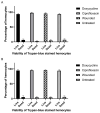Isolation and primary culture of Galleria mellonella hemocytes for infection studies
- PMID: 33520196
- PMCID: PMC7818094
- DOI: 10.12688/f1000research.27504.2
Isolation and primary culture of Galleria mellonella hemocytes for infection studies
Abstract
Galleria mellonella larvae are increasingly used to study the mechanisms of virulence of microbial pathogens and to assess the efficacy of antimicrobials. The G. mellonella model can faithfully reproduce many aspects of microbial disease which are seen in mammals, and therefore allows a reduction in the use of mammals. The model is now being widely used by researchers in universities, research institutes and industry. An attraction of the model is the interaction between pathogen and host. Hemocytes are specialised phagocytic cells which resemble neutrophils in mammals and play a major role in the response of the larvae to infection. However, the detailed interactions of hemocytes with pathogens is poorly understood, and is complicated by the presence of different sub-populations of cells. We report here a method for the isolation of hemocytes from Galleria mellonella. A needle-stick injury of larvae, before harvesting, markedly increased the recovery of hemocytes in the hemolymph. The majority of the hemocytes recovered were granulocyte-like cells. The hemocytes survived for at least 7 days in culture at either 28°C or 37°C. Pre-treatment of larvae with antibiotics did not enhance the survival of the cultured hemocytes. Our studies highlight the importance of including sham injected, rather than un-injected, controls when the G. mellonella model is used to test antimicrobial compounds. Our method will now allow investigations of the interactions of microbial pathogens with insect hemocytes enhancing the value of G. mellonella as an alternative model to replace the use of mammals, and for studies on hemocyte biology.
Keywords: 3Rs; Galleria mellonella; hemocytes; infection model.
Copyright: © 2021 Senior NJ and Titball RW.
Conflict of interest statement
Competing interests: Richard W Titball is a shareholder in Biosystems Technology Ltd
Figures






References
Publication types
MeSH terms
LinkOut - more resources
Full Text Sources
Other Literature Sources

